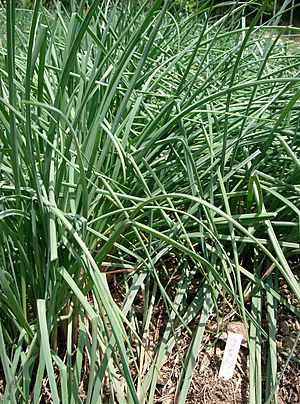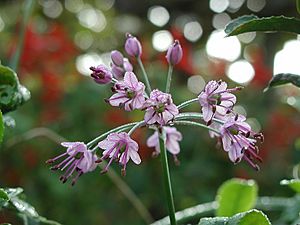Chinese onion facts for kids
Quick facts for kids Chinese onion |
|
|---|---|
 |
|
| Conservation status | |
| Scientific classification |
Allium chinense is a plant also known as Chinese onion, Chinese scallion, or Japanese scallion. It's a type of Allium plant, which means it's related to familiar foods like onions, shallots, leeks, chives, and garlic. This plant is native to China and is grown in many other countries around the world because it's edible.
Where It Grows
Allium chinense originally comes from China. You can find it growing naturally in many Chinese provinces like Anhui, Fujian, Guangdong, and Hunan. Over time, it has also started to grow naturally in other parts of Asia and even in North America.
How People Use It
For Cooking
The Chinese onion has a very mild and fresh taste. Because of this, it's often pickled and served as a side dish. It helps to balance out stronger flavors in a meal.
For example, in Japanese cuisine, pickled Allium chinense is called rakkyō (辣韮 or 薤). People often eat it as a garnish with Japanese curry. In Vietnam, pickled Allium chinense is known as củ kiệu. It's a popular dish served during Tết, which is the Lunar New Year celebration. You can often find glass bottles of these white rakkyō pickles in Asian supermarkets.
For Health
Allium chinense is also used in folk medicine. It's sometimes included in tonics. People believe it can help with the intestines and act as a stomachic, which means it's thought to be good for the stomach.
See also
 In Spanish: Allium chinense para niños
In Spanish: Allium chinense para niños



